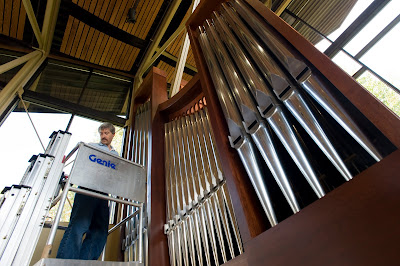UPB Receives $350,000 Gift for Organ
 The University of Pittsburgh at Bradford has received a $350,000 gift from George Duke in honor of his mother, Sarah B. Dorn, for a 17-rank pipe organ in the campus’s new chapel.
The University of Pittsburgh at Bradford has received a $350,000 gift from George Duke in honor of his mother, Sarah B. Dorn, for a 17-rank pipe organ in the campus’s new chapel.“The exquisite Schantz organ was the missing element in an otherwise perfectly designed and beautifully built chapel,” said Dr. Livingston Alexander, president of Pitt-Bradford. “We’re deeply grateful to Mr. Duke for enabling us to acquire the instrument and name it in honor of Mrs. Sarah Dorn.”
Flue voicers Stephen Leslie and Jeffrey Herr of Schantz Organ Co. spent several weeks on campus doing the final voicing and tuning for the instrument, which was installed late last month.
Each of the organ’s 1,020 pipes is an individual instrument that must be voiced and tuned on site. The pipes can produce notes from 32 cycles per second to 16,000 cycles per second, a range of eight octaves, essentially allowing one person to reproduce an orchestra. Different ranks of pipes are created differently to simulate the reeds, flutes and brass.
Just as the members of an orchestra tune their instruments to one note prior to playing, Leslie and Herr use a strobe to tune one pipe to make sure that its pitch is at the industry standard of A = 440 cycles per second. They then tune the rest of the pipes in relation to the first one – entirely by ear.
Leslie sat at the console, which is crafted in a beautiful black cherry wood cabinet while Herr climbed a ladder into one of the two large cases (also crafted in cherry) that house the pipes and ornament the front of the chapel sanctuary.
Herr worked in a pipe chamber about the size of a closet surrounded by pipes as small as pencils and as large as small tree trunks. The majority of the pipes are made of a tin-lead alloy, and some are made of select poplar and wood to produce different tones. Although some of the pipes are visible in the façade of the cases, far more are contained inside.
Leslie played and listened nearly constantly while Herr pulled pipes and worked on them.
They exchanged conversation over the organ playing like two parts of one mind. Leslie played a note while Herr adjusted the pipe, producing sounds ranging from a flute to a violin, trumpet or oboe.
“I’m the hands of his mind,” Herr said while working on one of the reed pipes. “Ahh – we’ve got a squawker here.”
Leslie started to say “go ahead and take it apart” at the same time Herr said “I’m going to take it apart.”
This particular pipe is shaped like a trumpet and has a brass “reed” that functions just like the reed in a woodwind instrument. The reed needs to be recurved to catch the air coming through the pipe correctly.
When asked how the voicers know what to do with each pipe, Leslie answered, “Where an artist sees in color, we organ builders hear in color.”
Even at a few minutes per pipe, the process takes more than a week and this, the flue voicers say, is considered a small organ. Schantz produces about 700 ranks each year, some in organs that have more than 100 ranks.
But in the intimacy of Wick Chapel, this little organ will be just right.
“This two-ton titan of tone will come to life in the new Harriett Wick Chapel, where every seat is in a musical garden,” Leslie said. “It really is a perfect match of organ to room. You see, the best stop on an organ is the room.”
The organ will be featured in recitals and concerts and at weddings held at the chapel. It also can “record” a musical piece such as “Here Comes the Bride” and be played back like a player piano.
Pictured, an employee of Schantz Organ Co. installs the 17-rank organ in honor of Sarah B. Dorn in the chapel on the campus of the University of Pittsburgh at Bradford.
Pitt-Bradford photo by Alan Hancock


.jpg)

Comments